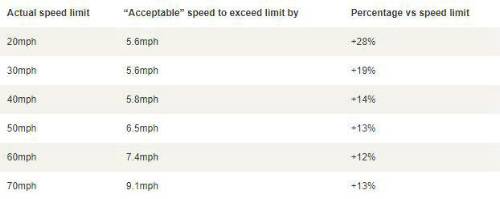This fast and loose attitude could be why nearly two in five (39 per cent, or 16 million Brits) of drivers have been caught speeding.
Those caught typically go far beyond the speed drivers deem to be ‘acceptable’, with those caught in a 30mph zone travelling an average of 37mph (23 per cent over the limit), in a 40mph zone they typically drove at 51mph (28 per cent over) and those in a 50mph zone drove at 61mph (22 per cent over).
Table one: Perception of “acceptable” speed over the limit
The majority of drivers are caught speeding in 30mph zones (55 per cent), followed by 40mph (20 per cent) and 50mph (12 per cent) zones. Just one in 12 (eight per cent) of those caught speeding are caught in 70mph zones, yet these are considered the most appropriate place to speed. Motorways (37 per cent) and dual carriageways (24 per cent) are seen as the most acceptable roads for speeding, while just two per cent believe it is acceptable to speed in traffic calming zones.
Over three quarters (78 per cent), some 31 million adults, admit to speeding, with over two million drivers (five per cent) speeding on every journey they make, while a further 4.7 million (12 per cent) say they speed on most of their journeys.
The South West is the speeding capital of the UK, where 84 per cent of drivers admit to speeding, while ‘only’ 71 per cent of drivers in Yorkshire report that they exceed the speed limit.
When asked why they speed, half of speeders (51 per cent) admit to doing so without realising it, but slow down when they notice.
However, a third (34 per cent) deliberately speed when the road is empty, while a fifth (19 per cent) do so when they are running late. One in 20 (five per cent) admit they speed because they enjoy the thrill of driving quickly.
Rob Miles, director of car insurance at Direct Line commented: “Speeding is one of the biggest causes of accidents and casualties on UK roads. The research suggests that it is often not deliberate, as drivers may be unaware that they may are creeping above the limit. However, speed limits are set for a reason and 20mph and 30mph zones are often around schools, hospitals and other highly pedestrianised zones, where going over the limit could prove fatal in the event of an accident.”
Table two: Reasons for speeding
Despite the high numbers who speed without realising it, the majority (85 per cent) of drivers say they check their speedometers often, with two fifths (41 per cent) claiming to check it “very often”. Just one in nine (11 per cent) admit to only checking their speedometer occasionally.
Speed awareness test findings
Further research4 conducted by Direct Line Car Insurancetested participants’ awareness of their speed when driving. They were asked to travel at speeds of 30mph and 70mph using their speedometer (control), with the speedometer covered up (blind test) and with a head-up display (head-up) which allowed them to view their speed on their windscreen.
While participants were able to keep their speed in line with the limits in the control test, they strayed significantly when unable to view their speed. In the ‘blind test’ drivers averaged speeds of 5.6mph over the limit (19 per cent) in the 30mph zone and 3.3mph over the limit (five per cent) in the 70mph zone.
With the head-up display visible, drivers were much more able to regulate their speed, travelling at an average speed of 30.9mph in the 30mph zone (three per cent over) and 70.1mph in the 70mph zone. These findings suggest that the widespread introduction of head-up speedometers will be valuable in helping drivers regulate their speeds in urban environments, where there many factors competing for drivers’ attention.
Additional testing by Direct Line revealed that drivers travelling around a curve in the road are much more conservative with their speed. When asked to travel at 40mph around a slight curve, participants averaged just 37.6mph in the control setting – six per cent below the speed limit. However, this rose by seven per cent to 40.1mph in the ‘blind test’, indicating a slight increase in the unawareness of speed, even though the resulting speeds were still in line with the speed limit. This also suggested that participants were unwittingly driving at a pace faster than they would normally be comfortable with, which can result in mistakes being made and accidents occurring.
Rob Miles, director of car insurance at Direct Line, commented: “It is interesting to see that the head-up display made drivers much more aware of their speed than with a standard speedometer. The other benefit of this technology is that it improves safety as drivers are able to monitor their speed while also keeping their eyes on the road. In-car technology is improving constantly and, with more and more cars including these important safety features, we will hopefully start to see a decrease in the number of speeding related accidents and casualties in the future.”
|



